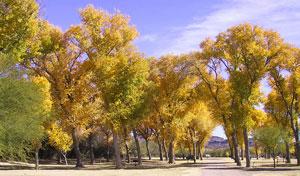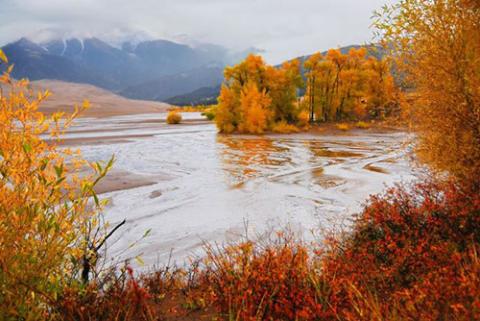Many areas in the National Park System are justly famous for autumn color, and visitors flock to places like Great Smoky Mountains National Park, Acadia National Park and Rocky Mountain National Park to enjoy the seasonal palette of natural beauty. There are, however, some other parks where fall color can be either a surprise'or a treasured experience for savvy travelers.
Great Sand Dunes National Park and Preserve in central Colorado is best-known for the highest sand dunes in North America, and the park offers plenty of opportunities for enjoying views or taking photos of dramatic landscapes.
Many of us, however, may not associate trees of any kind, much less great fall color, with this inland "ocean of sand." If that's the case, as the above photos prove, we'd be missing out on some spectacular views. You don't even have to venture very far off the road for some of these great vistas; the top photo was taken last week just north of the Dunes Parking Area, and shows off the golds in the cottonwood trees and the dark red in the three-leaf sumac.

Cottonwood Campground in Big Bend National Park. Photo by Gerry Brush via Creative Commons and Flickr.
Desert parks may offer other possibilities for fall color surprises, and although you aren't going to find sweeping views of entire mountainsides ablaze with color, areas near water sources can still offer some fine views. A bonus for these areas is an extended season for autumn, since cooler temperatures and resulting color may not occur until November or even later.
One example is Big Bend National Park, where the aptly-named Cottonwood Campground offers lovely golden color in the late fall. The campground is described on the park website as a "quiet, shady desert oasis located between the Castolon Historic District and scenic Santa Elena Canyon, "and the campground's grove of cottonwood trees provides a lovely autumn bonus.
How about it, Travelers? Do you have some other favorite spots for unexpected autumn color?




Comments
The alpine meadows at Mt. Rainier turn into a multicolored tapestry in the fall, and farther down into the forest, the vine maples provide spots of beautiful color among the evergreens.
When I was at the Gila cliff dwellings in November of 1999, I remember the cottonwoods being this absolutely gorgeous luminous gold, too.
In Glacier NP the tamaracks (larch) have turned yellow before the needles fall off. In particular Bowman and Kintla Lake hillsides are beautiful now. Along Lk. McDonald the hills are also tamarck-spotted, along with aspen yellow that hasn't fallen, yet.